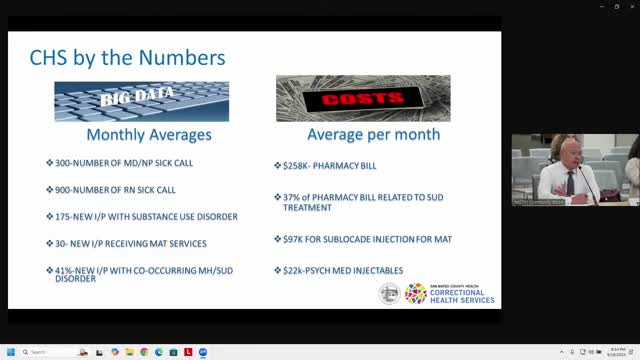Health crisis deepens in behavioral health unit
September 20, 2024 | San Mateo County, California
This article was created by AI summarizing key points discussed. AI makes mistakes, so for full details and context, please refer to the video of the full meeting. Please report any errors so we can fix them. Report an error »

In a recent government meeting, officials discussed the pressing health challenges faced by incarcerated individuals, highlighting significant concerns regarding mental health and substance use disorders (SUD). The meeting revealed that approximately 41% of new patients entering the system are grappling with either a mental health disorder or SUD, underscoring the critical need for comprehensive healthcare services within correctional facilities.
Monthly statistics presented indicated an average of 900 sick calls, with 175 new patients engaging in SUD treatment each month. Currently, only 30 of these patients are receiving medication-assisted treatment (MAT) services, raising questions about the adequacy of available resources. The financial burden of healthcare in these facilities is substantial, with the county spending around $258,000 monthly on pharmacy services—a 10% increase from the previous year. Notably, 37% of these costs are unrelated to SUD treatment, with significant expenditures on long-term injectable psychiatric medications.
Staffing levels were also a focal point of the discussion. The facility employs a mix of full-time doctors, nurse practitioners, and registered nurses, with doctors present on-site three days a week. The behavioral health unit currently accommodates 49 male patients and 18 female patients, with officials acknowledging that demand sometimes exceeds capacity. In such cases, clinicians assess individuals and prioritize them for admission as space becomes available.
The meeting concluded with a call for enhanced support and resources to address the complex health needs of the incarcerated population, particularly in light of the high prevalence of chronic conditions such as hypertension and diabetes among patients who often lack consistent access to routine care.
Monthly statistics presented indicated an average of 900 sick calls, with 175 new patients engaging in SUD treatment each month. Currently, only 30 of these patients are receiving medication-assisted treatment (MAT) services, raising questions about the adequacy of available resources. The financial burden of healthcare in these facilities is substantial, with the county spending around $258,000 monthly on pharmacy services—a 10% increase from the previous year. Notably, 37% of these costs are unrelated to SUD treatment, with significant expenditures on long-term injectable psychiatric medications.
Staffing levels were also a focal point of the discussion. The facility employs a mix of full-time doctors, nurse practitioners, and registered nurses, with doctors present on-site three days a week. The behavioral health unit currently accommodates 49 male patients and 18 female patients, with officials acknowledging that demand sometimes exceeds capacity. In such cases, clinicians assess individuals and prioritize them for admission as space becomes available.
The meeting concluded with a call for enhanced support and resources to address the complex health needs of the incarcerated population, particularly in light of the high prevalence of chronic conditions such as hypertension and diabetes among patients who often lack consistent access to routine care.
View full meeting
This article is based on a recent meeting—watch the full video and explore the complete transcript for deeper insights into the discussion.
View full meeting
